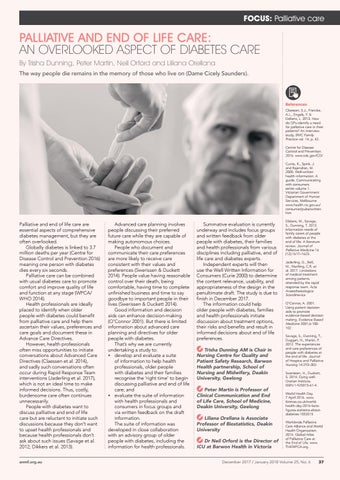FOCUS: Palliative care
PALLIATIVE AND END OF LIFE CARE: AN OVERLOOKED ASPECT OF DIABETES CARE By Trisha Dunning, Peter Martin, Neil Orford and Liliana Orellana The way people die remains in the memory of those who live on (Dame Cicely Saunders).
References Claessen, S.J., Francke, A.L., Engels, Y. & Deliens, L. 2013. How do GPs identify a need for palliative care in their patients? An interview study, BMC Family Practice vol. 14, p. 42. Centre for Disease Control and Prevention. 2016. www.cdc.gov/CD/ Currie, K., Spink, J. and Rajendran, M. 2000. Well-written health information: A guide. Communicating with consumers series volume 1. Victorian Government Department of Human Services, Melbourne www.health.vic.gov.au/ consumer/pubs/written. htm
Palliative and end of life care are essential aspects of comprehensive diabetes management, but they are often overlooked. Globally diabetes is linked to 3.7 million deaths per year (Centre for Disease Control and Prevention 2016) meaning one person with diabetes dies every six seconds. Palliative care can be combined with usual diabetes care to promote comfort and improve quality of life and function at any stage (WPCA/ WHO 2014). Health professionals are ideally placed to identify when older people with diabetes could benefit from palliative care and help them ascertain their values, preferences and care goals and document these in Advance Care Directives. However, health professionals often miss opportunities to initiate conversations about Advanced Care Directives (Claessen et al. 2014), and sadly such conversations often occur during Rapid Response Team interventions (Jaderling et al. 2017), which is not an ideal time to make informed decisions. Thus, costly, burdensome care often continues unnecessarily. People with diabetes want to discuss palliative and end of life care but are reluctant to initiate such discussions because they don’t want to upset health professionals and because health professionals don’t ask about such issues (Savage et al. 2012; Dikkers et al. 2013). anmf.org.au
Advanced care planning involves people discussing their preferred future care while they are capable of making autonomous choices. People who document and communicate their care preferences are more likely to receive care consistent with their values and preferences (Swerissen & Duckett 2014). People value having reasonable control over their death, being comfortable, having time to complete unfinished business and time to say goodbye to important people in their lives (Swerissen & Duckett 2014). Good information and decision aids can enhance decision-making (O’Connor 2001). But there is limited information about advanced care planning and directives for older people with diabetes. That’s why we are currently undertaking a study to: • develop and evaluate a suite of information to help health professionals, older people with diabetes and their families recognise the ‘right time’ to begin discussing palliative and end of life care; and • evaluate the suite of information with health professionals and consumers in focus groups and via written feedback on the draft information. The suite of information was developed in close collaboration with an advisory group of older people with diabetes, including the information for health professionals.
Summative evaluation is currently underway and includes focus groups and written feedback from older people with diabetes, their families and health professionals from various disciplines including palliative, end of life care and diabetes experts. Independent experts will then use the Well Written Information for Consumers (Curie 2000) to determine the content relevance, usability, and appropriateness of the design in the penultimate draft. The study is due to finish in December 2017. The information could help older people with diabetes, families and health professionals initiate discussion about treatment options, their risks and benefits and result in informed decisions about end of life preferences. Trisha Dunning AM is Chair in Nursing Centre for Quality and Patient Safety Research, Barwon Health partnership, School of Nursing and Midwifery, Deakin University, Geelong Peter Martin is Professor of Clinical Communication and End of Life Care, School of Medicine, Deakin University, Geelong Liliana Orellana is Associate Professor of Biostatistics, Deakin University Dr Neil Orford is the Director of ICU at Barwon Health in Victoria
Dikkers, M., Savage, S., Dunning, T. 2013. Information needs of family carers of people with diabetes at the end of life: A literature review. Journal of Palliative Medicine 16 (12):1617–1623. Jaderling, G., Bell, M., Martling, C.R. et al. 2017. Limitations of medical treatment among patients attended by the rapid response team. Acta Anaesthesiologica Scandinavica O’Connor, A. 2001. Using patient decision aids to promote evidence-based decision making. Evidence Based Medicine 2001;6:100102 Savage, S., Dunning, T., Duggan, N., Martin, P. 2012. The experiences and care preferences of people with diabetes at the end of life. Journal of Hospice and Palliative Nursing 14:293–302. Swerissen, H., Duckett, S. 2014. Dying well. Grattan Institute. ISBN:1-925015-61-4. World Health Day. 7 April 2016. www. ibtimes.co.uk/worldhealth-day-2016-factsfigures-statistics-aboutdiabetes-1553515 Worldwide Palliative Care Alliance and World Health Organization. 2014. Global Atlas of Palliative Care at the End of Life. www. THEWPCA.org.
December 2017 / January 2018 Volume 25, No. 6 37
